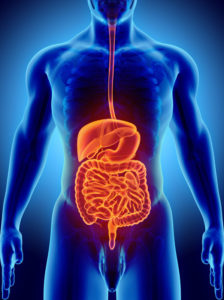Abdominal Pain 101
By Eva Briggs, M.D.
 One of the most common reasons people seek medical care is abdominal pain. I often hear people say, “Just get an X-ray, doc.”
One of the most common reasons people seek medical care is abdominal pain. I often hear people say, “Just get an X-ray, doc.”
But it’s not that simple.
Many different things, especially as people get older, can cause abdominal pain. And an X-ray will reveal only some of them.
Most people assume that pain in the abdomen must be coming from the intestinal tract. And, yes, there is an assortment of maladies that can arise from digestive organs. Common examples include the stomach (ulcers), appendix (infection), small intestine (obstruction, irritable bowel syndrome, twisting), or colon (diverticulitis, tumors).
The underlying cause could be related to the circulatory system: an abdominal aneurysm can leak or rupture. Vascular disease can block blood flow to the intestines and cause severe pain. Diseases of the liver and spleen can cause pain. Stones blocking the gallbladder duct produce pain and infection. Kidney infections and stones, ovarian cysts, pregnancy problems, prostate infections and hernias are other potential pain sources. Even disease that is not located inside the abdomen can make your belly hurt: some heart attacks or pneumonia in the lower part of the lungs.
So how does your medical provider figure this all out?
Your provider will start by asking what seems like a million questions. Your story is an important piece of the puzzle. Where is the pain is located? Did it start at one place and move to another part of the abdomen? Does it spread to another part of the body such as the back or the chest? When did it start? Is it there all the time, does it that come and go, and is it getting worse? Does anything trigger the pain or make it worse? Is there anything that relieves the pain? Do you have any other symptoms, such as vomiting, constipation, diarrhea, urine problems, cough, fever, etc.? What medical problems or past surgeries have you had?
Next comes the physical exam. The first component is inspection for distention, bruises, scars or other clues. Other techniques are auscultation (listening for bowel sounds and abnormal circulation sounds), percussion (tapping to assess for gas and fluid), and palpation (feeling for masses, enlarged organs, and tenderness.)
Your history and exam will guide the selection of laboratory studies. Typical tests for abdominal pain include urinalysis, a urine pregnancy test in women of childbearing age, a complete blood count, liver enzymes, amylase and lipase (two enzymes made by the pancreas), and stool testing for hidden blood.
An X-ray is one type of imaging study. X-rays may show an abnormal pattern of gas in the intestines, such as might occur with a blockage. Some kidney stones will show up on an X-ray. An X-ray might show constipation, although there is some disagreement as to how useful an X-ray is for this purpose.
Ultrasound is often used to examine the gallbladder. Other uses of ultrasound are evaluation of the kidneys, female pelvic organs and spleen. Ultrasound may help to diagnose appendicitis, especially in children.
A CAT scan can often provide information about abdominal and pelvic structures. But it does involve more radiation than an X-ray. Depending on what the doctor is looking for, you may need an injection of dye. Some typical uses of CAT scan in the urgent care include suspected kidney stones, appendicitis and diverticulitis.
MRI is another noninvasive way to obtain images of the body. It can’t be used in patients with certain types of metal in their body. MRI is expensive and is reserved for special cases.
With so many possible causes for abdominal pain, and so many possible tests, don’t be surprised if you are sent to the emergency room. Sometimes that’s the only way to quickly get to the root of the problem.
Eva Briggs is a medical doctor who works at two urgent care centers (Central Square and Fulton) operated by Oswego Health.

